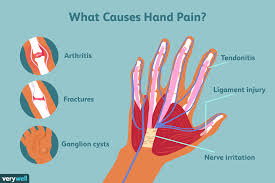Experiencing pain in your left hand can be both frustrating and alarming. Whether it's a dull ache or sharp pain, understanding the potential causes can help you determine the best course of action. In this article, we'll explore the various reasons for left-hand pain, symptoms you should be aware of, and possible treatments to consider.
Pain in the left hand can stem from various sources. Let's look at some common causes:
Overuse and Repetitive Strain
Repetitive activities such as typing, writing, or using tools can lead to overuse injuries. This is particularly common in people who work with their hands frequently. Conditions like tendonitis or carpal tunnel syndrome often result from repetitive strain, causing pain and discomfort in the left hand.
Injuries and Trauma
Accidents or impacts can lead to sprains, fractures, or dislocations in the hand. Even a minor fall or bump can cause significant pain if it affects a vulnerable area. Sports injuries are also a frequent cause of hand pain, particularly in activities that involve gripping or hitting.
Arthritis
Arthritis is a common culprit when it comes to hand pain. It occurs when the cartilage in your joints wears down, leading to inflammation and discomfort. Osteoarthritis and rheumatoid arthritis are two types that commonly affect the hands, causing joint stiffness and pain.
Nerve Compression
Conditions such as carpal tunnel syndrome involve compression of the median nerve in the wrist, which can lead to pain and tingling in the hand and fingers. Ulnar nerve entrapment, which affects the inner arm and hand, can also cause similar symptoms.
Circulatory Issues
Poor circulation can lead to numbness and pain in the hands. Conditions like Raynaud's disease cause blood vessels to constrict, leading to reduced blood flow and discomfort in the fingers and hands.
Symptoms to Watch For
Understanding the symptoms that accompany hand pain can help in identifying the underlying issue. Here are some common symptoms to be aware of:
-
Swelling and Redness: This can indicate inflammation or an injury.
-
Tingling or Numbness: Often associated with nerve compression or poor circulation.
-
Stiffness: A common symptom of arthritis, making it difficult to move the fingers or hand.
-
Weakness: Difficulty in gripping or holding objects could suggest nerve or muscular issues.
-
Sharp or Dull Pain: Different types of pain can point to various causes, from injuries to chronic conditions.
When to Seek Medical Attention
While some hand pain can be managed at home, certain symptoms warrant a trip to the doctor:
-
Severe pain that doesn't improve with rest or over-the-counter pain relief.
-
Persistent numbness or tingling may indicate nerve damage.
-
Visible deformity or swelling that doesn't subside.
-
Signs of infection, such as warmth and redness, are accompanied by fever.
If you're ever in doubt, it's always better to consult a healthcare professional to rule out serious conditions.
Treatments and Remedies
Depending on the cause of your hand pain, various treatments and remedies might help:
Rest and Immobilisation
Giving your hand time to rest can help reduce inflammation and pain. Using a brace or splint can immobilise the area, preventing further strain.
Ice and Heat Therapy
Applying ice packs to a painful area can reduce swelling and numb the pain. Heat therapy, on the other hand, can help relax muscles and improve circulation.
Medication
Over-the-counter pain relievers like ibuprofen or acetaminophen can help manage pain and inflammation. In some cases, a doctor might prescribe stronger medication or corticosteroid injections for more severe pain.
Physical Therapy
Working with a physical therapist can help strengthen the muscles and improve flexibility. They can also provide exercises tailored to your specific condition to aid in recovery.
Lifestyle Changes
Adjusting activities that contribute to hand pain can be beneficial. For instance, using ergonomic tools, taking frequent breaks, and practising hand exercises can prevent overuse injuries.
Specialized Footwear
Interestingly, wearing proper footwear can indirectly benefit hand health by improving overall posture and reducing strain. Brands offering comfortable or diabetic shoes can make a difference, especially if your hand pain stems from broader musculoskeletal issues.
Conclusion
Understanding the causes of left-hand pain is the first step towards finding relief. Whether it's due to overuse, injury, or an underlying medical condition, identifying the source of your pain can guide you towards effective treatment. If you're experiencing persistent or severe symptoms, don't hesitate to seek medical advice to ensure a proper diagnosis and treatment plan.
By taking proactive steps and making informed choices, you can manage your hand pain effectively and maintain your quality of life.








